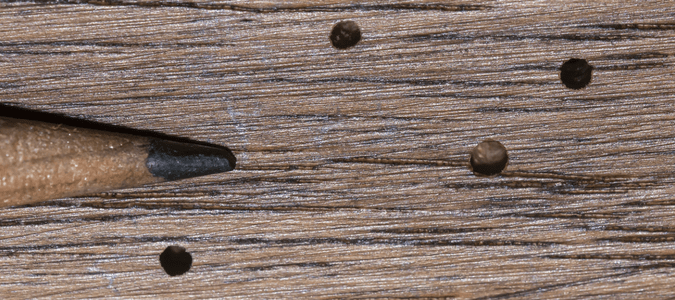
As a homeowner in the southern United States, you’re no stranger to finding bugs in your house. Spiders can be found building their webs in dark corners. Ants find their way in and need to be dealt with. In the warmer months, it seems like half a dozen flies find their way in every time you open the door.
When you noticed a sprinkling of something that looked like sawdust on the floor by the door to the garage and discovered a few tiny round holes in the wood frame, your mind went to the obvious place: termites. Or maybe it could be carpenter ants?
When you couldn’t find any of the other telltale signs of those unwanted guests, you assumed you must have been wrong. Maybe it wasn’t bugs after all.
While termites and carpenter ants are the wood pests that homeowners typically hear the most about, they’re not the only ones out there. One of the biggest dangers to wood in the home comes from a bug you’d probably never guess: the wood-boring beetle.
A beetle?
That’s right.
In this post, we’ll talk about the different types of wood boring beetles you might encounter and what you can do to protect your home from these destructive insects.
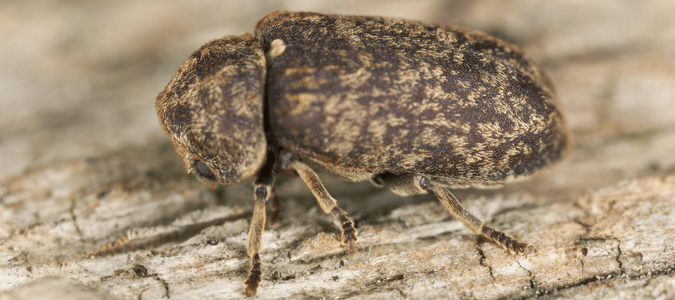
The Deathwatch Beetle And Other Insects That Damage Homes
There are three main groups of insects that bore through wood: the powderpost beetle, the deathwatch beetle, and the false powderpost beetle.
If you store firewood inside your house, it is also possible that you might notice several other types of wood beetles, such as flatheaded or roundheaded borers, but you don’t have to worry as much about them. Since these species are forest insects, they usually won’t feast on wood furniture inside homes or other wooden structures. The worst they’re likely to do is scare you when they pop out of the wood in their attempt to leave and get back home.
So, for this post, we’ll concentrate on the wood-borers you really do need to worry about. The powderpost, deathwatch, and false powderpost beetles burrow into and feed in wood right after they hatch. They then tunnel through the wood as they grow and bore exit holes to leave the wood for good as adults.
Why should these behaviors worry you?
For one, all those little exit holes in the wood aren’t exactly attractive. No one wants furniture or other visible pieces of wood around their house to look like Swiss cheese. While you can cover and patch them fairly easily in most cases, if you have an infestation of wood-boring beetles, this will keep happening.
Second, and far more important, is how all those tunnels impact the structural integrity of the wood. Over time, it can have quite an impact. If wood-borers tunnel their way through a door frame, it may not be a reason for concern. This behavior becomes far more important, however, if the wood is weakened in your furniture. Results can be more significant if the beams supporting your house can no longer hold up the weight.
Simply put, wood-boring beetles can wreak all kinds of havoc.
What can you do? The first step is to understand how to recognize them and differentiate between the ones that are truly dangerous and those that aren’t.
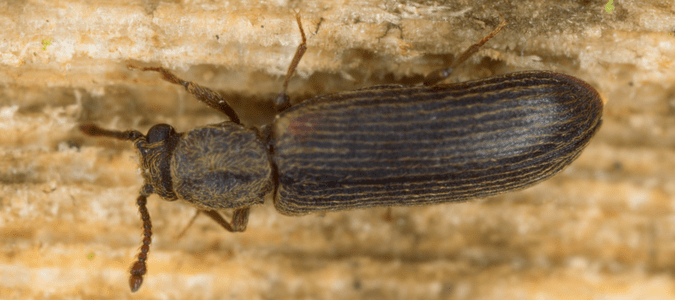
Wood Boring Beetles: Identification
How can you tell if you’re dealing with a wood-boring beetle? You need to both look for the signs of infestation and identify them if you see an adult, which homeowners often find already dead.
One quick question before we start talking beetles, since termites also damage wood: what do termites look like to the human eye? Workers can be creamy white, brown or black with large mouthparts. Soldiers are often described as a larger, meaner-looking counterpart of the workers. Swarmers, which are often confused with ants, have straight antennae (on ants, these are curved), two sets of wings that are longer than the body and a non-segemented thorax (as opposed to ants, that have the characteristic pinched waist).
Powderpost Beetles
This group gets their name from the incredibly fine frass they leave behind–a combination of powdery wood dust and feces with the consistency of baking powder. Typically, this frass stays inside the tunnels unless something bumps it out.
Although powderpost beetles are sometimes lumped into a group of bugs that look like termites but aren’t because of the damage they do to wood, these insects are actually quite distinct, as you can see in the image above.
Larval Stage
Larvae are C-shaped and creamy white in color. Because they live inside the wood until they reach adulthood, you likely will not see any larvae.
Adult Stage
Powderpost beetles are incredibly tiny, ranging anywhere from 3/32” to ¼” long. These insects have long, narrow bodies that are reddish-brown to black in color. The holes that they make when boring their way out of wood are even smaller, measuring only 1/32” to 1/16” in diameter. Essentially, mature powderpost beetles are about the size of one of the letters that make up “In God We Trust” on a dime. Females lay their eggs on the surface of the wood.
Deathwatch Beetles
These types of beetles are also called furniture beetles, but that is a misleading name for a couple of reasons. First, they’re more commonly found in wood flooring and framing. Secondly, a different type of beetle, called Lyctid beetles, are more likely to be found in furniture.
So how did this beetle get such an intimidating name? These creatures have a habit of making tapping noises by knocking their heads against the wood inside of a home that they were feeding upon. Back in the days when people died in their beds, these sounds were considered a countdown to death. Creepy, right?
Larval Stage
C-shaped and white, these immature beetles have heads that are yellowish-brown. They also have black mandibles.
Adult Stage
Deathwatch adults are gray-brown and can be anywhere from ¼” to 3/8” in length. Their backs have patches of pale hair, and the body segment behind the head looks kind of like a hood. Their exit holes are bigger, at about 1/6” in diameter. Females lay their eggs on the surface of the wood.
False Powderpost Beetles
This group of beetles has the grittiest frass. The consistency of this insect’s waste materials is close to something like borax soap or a coarse powder. These beetles are also known as “cask borers” due to their tendency to go for oak soaked in wine, such as that found in wine barrels.
Larval Stage
There’s little to distinguish the larvae of these types of beetles. Like the others, they’re C-shaped, cream colored and grub-like in appearance.
Adult Stage
With bodies that are dark brown to black in coloration, these adult beetles have antennae, legs, and mouthparts that are red. Most false powderpost species are around ¼” in length, and they are “hooded” like deathwatch beetles, giving them a humpback appearance.
Flathead Beetles
Want to hear something frightening? Flathead wood boring beetles are also known as metallic wood borers. Before you start worrying that this species can eat through metal, though, you should know that the name comes from their appearance, rather than their diet.
Larval Stage
Like the other beetle larvae here, these beetles start out as C-shaped, cream-colored, legless grubs. What sets flathead larva apart is their wide thorax, which gives their head a wide, flat shape in the larval stage.
Adult Stage
Flathead wood borers vary greatly in size, anywhere from ¼” to 2 ½” in length. These insects’ bodies are long and oval-shaped, and they tend to have a metallic iridescence that makes them appear shiny.
Roundheaded Beetles
These beetles tend to attack trees that are weakened, stressed, dying or recently cut, as well as freshly cut timber that hasn’t dried out yet.
Larval Stage
Roundheaded beetle larvae are creamy white in color and grub-like in appearance. Unlike other types of beetle larvae, they are not C-shaped; rather, they are long and straight like a caterpillar or centipede.
Adult Stage
Much like flathead beetles, roundheaded borers vary in size, being anywhere from ¼” to 2 ½” long. These insects also possess the typical elongated oval beetle shape. These beetles are distinct because of the long antennae many of them have, which is why many people simply refer to them as “longhorned beetles.”
Remember that both flathead and roundheaded beetles are forest insects that only go after living or recently cut wood, which means they pose no risk to homes or furniture. The only time homeowners might need to worry is if they have sick, dying or recently cut trees on their property, because these types of trees are prime targets for these two varieties of beetles.
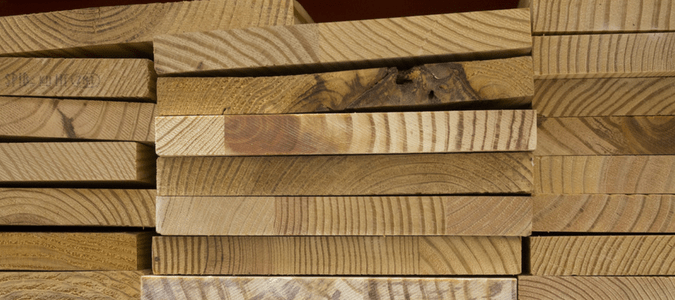
Wood Boring Beetles: Treatment & Prevention
There are a number of things that you can do to prevent wood-boring beetles from getting into the wood in your home. One thing to keep in mind, however, is that since most damage occurs beneath the surface, you may not actually see the insects responsible. For that reason, you may need expert help to confirm you do have a wood boring insect problem before you can move on to treatment and prevention.
Be Attentive With Lumber
If you are starting a construction project, make sure that the lumber you select is seasoned to avoid any damage from wood boring beetles. In addition, you should carefully inspect any wood items before buying them, including all lumber. Similarly, firewood needs to be kept outside until just before you’re going to use it, and carefully de-barked.
Seal All Wood Surfaces
Wood-boring beetles lay their eggs either on the surface or actually inside of wood. You can keep this from happening by using paint, polyurethane or varnish to seal any exposed wood with a layer of protectant.
Keep Moisture Levels Down
Most wood-boring beetles feed on wood that has at least a certain amount of moisture. If you can reduce the moisture in your wood, they will be less attracted to it. How do you do this? Ventilate with fans, central cooling, windows and so on. This is particularly important in places that can become extra humid, such as closets, attics and crawlspaces.
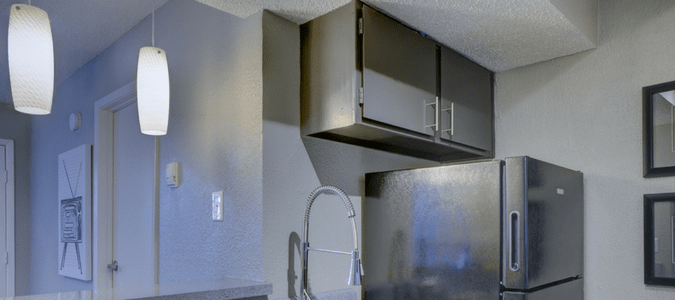
How To Get Rid Of Wood Borer Beetles
Obviously, prevention is preferable, but what if you already have an infestation? How can you eliminate it?
Heat
Wood-boring beetles can’t survive if the wood is heated to 120°F for at least 30 minutes. Some recommendations say that the heat needs to continue for up to six hours to ensure beetles in all stages of development are eliminated. Obviously, it’s not practical to put much from your home into the oven for this amount of time to address an insect problem, which is why a whole house heat remediation treatment performed by a trusted pest professional would be the best course of action.
Cold
Alternatively, you can lower the temperature of the wood to 0°F for 72 hours, though even this may not be long enough if the wood is thicker than two inches. Again, unless you have a walk-in freezer, this option may also be less than ideal.
Remove And Burn The Wood
If it is possible to isolate the problem pieces of wood and remove them, one of the best methods for eliminating these pests is to simply burn that wood and replace it with new, uninfected pieces. Again, probably not what most homeowners want to hear.
Liquid Insecticide
Can’t remove the infested wood? The next step is to apply liquid insecticide. This solution can only be applied to bare wood, so if you have an issue with wood that has been painted or otherwise sealed, you will need to remove this outer cover or layer before beginning. Liquid insecticides can be “painted” on or squirted into exit holes and tunnels. The most effective liquid insecticides can only be used by licensed professionals.
Fumigant
Truly extensive and wide-reaching wood-boring beetle infestations may require whole-house fumigation. This is both expensive and a huge undertaking, though, so make sure you are working with a trusted professional who has exhausted all other options before pursuing this option.
ABC Can Handle Any Pest Problem
As you can see, dealing with an infestation is no small task, so why not leave it to the professionals? The pest experts at ABC Home & Commercial Services have helped countless homeowners not only eradicate wood-boring beetle problems but also do what it takes to keep them from coming back. From identifying what pest is damaging your home to implementing an effective long-term treatment plan, you can protect your most important investment.
